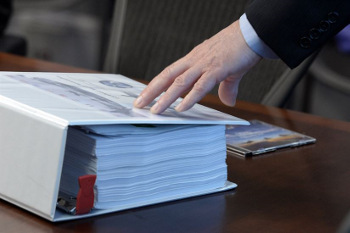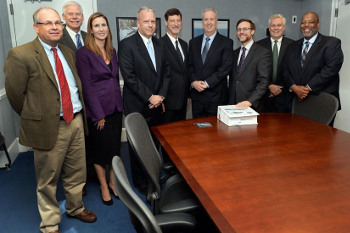 |
| November 15, 2016 | Volume 12 Issue 43 |
Designfax weekly eMagazine
Archives
Partners
Manufacturing Center
Product Spotlight
Modern Applications News
Metalworking Ideas For
Today's Job Shops
Tooling and Production
Strategies for large
metalworking plants
It's the 'new 1040' for industry: FlexFile System highlights government, industry partnership
By Jim Garamone, Department of Defense
The Pentagon's Cost Assessment and Program Evaluation office is making strides to be at the forefront of pushing innovation and cost savings in the department.
The office unveiled its new "FlexFile" program Nov. 2. It will be applied across the department, and it gives estimators the tools needed to evaluate huge DoD programs for the 21st century.

A hand rests on a display symbolizing how massive binders of financial tracking information paper trails have been pared down to software that can fit onto a single compact disc during a briefing at the Pentagon about F-35 cost tracking software developed by the Defense Department and contractor Lockheed Martin, Nov. 1, 2016. [DoD photo by EJ Hersom]
CAPE, as the office is known in the building, advises defense leaders on all aspects of the department. Duties include evaluating the cost effectiveness of defense programs and acquisitions.
1960s data tables
To do this, estimators need information from contractors, and until now, that meant information in tables designed in the 1960s, officials said. FlexFile is the infrastructure and process that allows contractors and CAPE to replace the archaic tables with modern data structures, they explained.
The demonstration of the capability was with a suitably large program: the F-35 Lot 3 procurement. CAPE and contractor Lockheed Martin worked together on the project.
Every DoD contract has reporting requirements that allow CAPE personnel to evaluate the contract costs. "We rely on historical data," said Steve Miller, director of the office's Advanced Systems Cost Analysis Division. "Cost and software data reports are the tables designed in the 1960s that industry provides to us on major defense acquisition programs today."
Before FlexFile, the reports required a lot of manual inputs by the contractors. This required a lot of checking and rechecking to ensure the accuracy of the data, and then it had to be hand-formatted and manually uploaded to CAPE.
Dave Marzo -- CAPE's F-35 cost lead, who has worked closely with Lockheed in implementing the FlexFile for F-35 -- showed a huge three-ring binder filled with hundreds of pages of today's tables. Bess Dopkeen, the program manager and the driving force for the Cost Assessment Data Enterprise, leads the broader effort at CAPE to transform the way the department collects data from contractors.
"It's like a 1040," Miller said. "Everybody's tax form has to look the same. But because of the manual piece to it, there is some subjectivity in every report."
Easier reporting
The idea was to make reporting easier for industry to do, and CAPE employees worked closely with industry partners to take the labor-intensive work out of the process. FlexFile makes the data easier to produce and makes it easier for CAPE to evaluate. The process reduces errors and "gives a better picture of these major programs," Miller said.

Jamie Morin, director of Cost Assessment and Program Evaluation, listens to a briefing about F-35 cost tracking software developed by the Pentagon and contractor Lockheed Martin at the Pentagon in Arlington, VA, Nov. 1, 2016. [DoD photo by EJ Hersom]
"It was a two-year process that still continues," he added. "The reason why we couldn't do it 10 years ago is that the IT systems had to mature enough to make it possible. On the industry side, it is the earned-value systems and accounting systems -- the big automated IT systems. On our side, it's the new ‘Big Data' analysis products that enable us to digest and analyze these enormous data sets from industry."
Industry was an integral part of the effort, Miller said. "Lockheed was the first with FlexFile, and we credit them with initiating this effort," he added, "but all the big corporations have bought into it."
Lockheed is also pleased with the results. Dave Demoret, the director of Program Control at the company, called FlexFile, "the first-of-its-kind important data transformation initiative."
"The ability to provide the DoD with more meaningful, flexible, and analytical data while decreasing the administrative burden on industry is a significant win for all involved," he said.
Headquarters reduction
CAPE, along with the rest of the Pentagon, is going through a headquarters reduction, and more downsizing is planned. "We have to do these things with fewer people and faster," Miller said.
FlexFile will be the "new 1040" for industry. "We designed it from the get-go to be a win-win for both industry and government," Miller said. "It provides us with better insight and better quality information. For them, it is much easier to produce."

Director of Cost Assessment and Program Evaluation Jamie Morin, third from left, stands with Defense Department and Lockheed Martin representatives after a briefing at the Pentagon about a new, jointly developed cost-tracking software, Nov. 1, 2016. [DoD photo by EJ Hersom]
The documents and reports are the foundations of doing cost estimates, officials said, the basis for all the office's budget projections and decisions.
The F-35 is a particularly good test for FlexFile, they added, noting that it is a very complex aircraft and acquisition item. FlexFile needed to accommodate three variants and the major systems aboard them. "It's not one single report, it is multiple reports -- hundreds of them -- and it is a huge burden," Miller said.
"The new system will allow evaluators to do ‘custom pulls' of that data," Marzo said. "Right now, we have to wade through archaic tables."
Dr. Jamie Morin, CAPE's director, also highlighted the significance of getting a FlexFile from the F-35.
"The F-35 is the department's largest acquisition program," he said. "If we can find a way to streamline data collection for the incredibly complex F-35, then we can do it with any program."
More than a 1040
"FlexFile is really more than a 1040," Miller said. "It is more like the electronic 1040 that most filers use today. It may take 80 hours to prepare one report the old way. By using FlexFile, that time is cut to eight."
Going back to the contractor's native data means less need for manual checking and rechecking, he explained.
"Since the system is already audited, you don't have those issues," Miller said, "because you are not introducing those manual components where the errors occurred."
CAPE is phasing the FlexFile program into new contracts, and the office encourages companies in older contracts to join the program, officials said.
Published November 2016
Rate this article
View our terms of use and privacy policy
